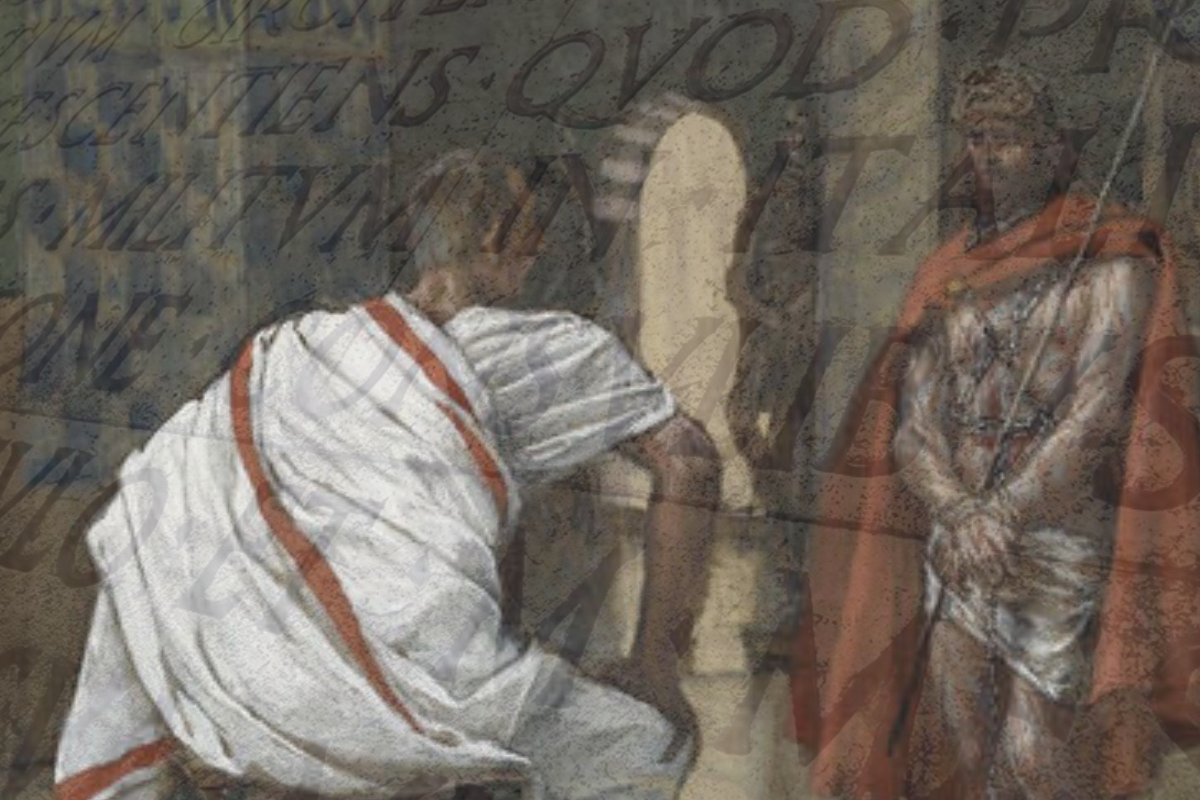
You may find this question either ridiculous or utterly irrelevant or perhaps even both? I wouldn’t be surprised at all. But, the real intent of this short reflection is genuine ‘inquiry’ rather than a ‘flight of fancy.
Remember The Passion of the Christ (2004)? Surprise! Mel Gibson presents Jesus’s conversation with Pilate in Latin (oops! We missed it!). Pilate begins (and flounders) in Aramaic while Jesus responds to him in Latin. Pilate, then, continues the conversation in Latin.
This is undeniably a departure from popular notions about Jesus and, thus, fraught with many difficulties. It does raise the larger question about the languages Jesus could speak (and understand).
Was Latin the official language?
The everyday language at Jesus’ time was Aramaic. It was not merely a “street language”. It could be written and read (John 19:19, 20; Lk 23:38 ESV). Hebrew (Ancient) was also common, but it was a kind of a “scribal language” used in the Temple and Synagogues for liturgical purposes and the public reading of Scripture.
Besides, both Latin and Greek were also common during Jesus’s time. While Latin was used extensively in Rome, Greek grew in popularity and influence across the Roman Empire and served as its “Lingua Franca”.
Many Jews used Greek because it was the language of Trade, Commerce and scholarship. It was previously thought that Latin was not widely spoken in first-century Israel. Perhaps, Latin was used only for official communique or inscriptions in the far posts of the Empire.
However, Eleanor Dickey (Learning Latin the Ancient way, 2016) points out that Latin was learned in the Eastern part of the Empire by Aramaic and Greek speakers. The interest in Latin was purely “utilitarian”.
It appears that Latin was used mainly to deal with the Roman army or assist Lawyers in legal courts. The Latin learning materials used were “Colloquia” (mostly useful dialogues and basic grammar).
Aramaic, Hebrew, Greek and Latin were used during Jesus’ time ( cf. John 19:19, 20; Lk 23:38 ESV). So, Jesus was probably familiar with Aramaic, Hebrew and Greek. But, did he speak Latin at all? Let’s find out!
Was Latin used as Soft Power?
Judea was infamous for its political volatility, and therefore, a military presence was deemed necessary. In all, there were four cohorts in Judea and cavalry at Caesaria. The Roman Governor, stationed at the Roman provincial capital, only visited Jerusalem during major feasts along with his other cohorts.
The presence of Roman soldiers in the troubled outpost is alluded to in the Gospels. We have several passages in the Gospels that involve soldiers. Soldiers were among those attracted to John, the Baptist’s charismatic preaching (Lk 3:14). Jesus met with a Roman centurion (cf. Matt. 8:5 – 13) and could have met many other soldiers stationed across Judea too!
We also read of soldiers’ presence with the high priest (cf.John 18:3; Mark 14:65) and Herod Antipas (Luke 23:6-12). Soldiers are also mentioned during the arrest of Jesus (John 18:3,12). But were the Jews exposed to Latin due to the Roman legions stationed in and around the region?
Christopher Zeichmann (The Roman Army and the New Testament, 2018) points that most Roman garrisons stationed in Palestine at the time of Christ were not drawn from the famous legions. Instead, they were “auxiliaries” recruited among men living in the area where they served.
Herod’s soldiers were most likely Jews and Gentile mercenaries. Similarly, the soldiers (hyperetai) with High Priest were mostly Jewish. Therefore, the soldiers were mostly Syrian Greeks who primarily spoke Greek.
The primary role of the soldiers was to protect Imperial interests, quell dissent and police. The Soldiers served a political function and were not expected to promote soft power.
Although the auxiliaries did not function as an occupying force, the soldiers could exercise power on the streets through brute force. Jesus’ teaching on ‘walking the extra mile (cf Matt. 5:41) alludes to its legitimization of power by Roman Law. Further, the Baptist’s admonishment suggests violence, false cases, and extortion (Lk 3:14).
It is unlikely that the soldiers – drawn from the non-Roman populace – popularised Latin at the ground level. In any case, these soldiers were mostly seen as “traitors” to the Jewish cause, and any social interaction with the soldiers was minimal.
The presence of senior officers who were ethnically Roman or Italian is inevitable, particularly when Judea and Jerusalem were under the control of Roman Governors. The mention of χιλίαρχος (chiliarchos translated as commander of a cohort, John 18:12) indicates that Roman soldiers were also present along with the High Priest’s Soldiers.
The Latin influence of the Auxiliaries on the general populace seems minimal, with the majority of soldiers being Greek or Jewish. Latin was probably limited only to administrative decrees and legal verdicts barring informal usages.
A case in this point is the Inscription put on Jesus’ Cross – Jesus of the Nazareth, the King of Jews (John 19:19, 20; Lk 23:38) – written in Latin along with (along with Aramaic and Greek)
Latin in the realm of Wider Culture!
The influence of Latin was not limited to the realm of Politics. Esther Laverne ( A study of Latin loanwords in the NewTestament, 1949) notes at least thirty Latin words (coins, weights and measures, Judiciary, military, politics, articles of clothing, writing materials and others) transliterated into the Greek of the New Testament.
Interestingly, Mark refers to the Roman officer with a Latin loanword κεντυρίων (kenturion), rather than the usual greek term hekatontarchos. Mark’s intimacy with Latin is often used to support the Roman origins of his Gospel. (cf. Brian J. Incigneri. The Gospel to the Romans: The Setting and Rhetoric of Mark’s Gospel, 2003).
True, certain Latinisms (σπεκουλάτωρ – Executioner, κεντυρίων – Centurion, and κοδράντης – Roman Coin) betray Mark’s residency in Rome. However, some Latinism employed could have been learnt outside of Rome. ( cf. Cadbury, The Making of Luke-Acts 1958), These loan words (military and commercial terms) could perhaps point to the influence of Latin during the time of Jesus.
Surprisingly, the greatest number of occurrences of Latin words is found in Matthew’s Gospel and not in Mark’s Gospel (presumably written from Rome). We can, then, glean the extent of Roman influence on the wider culture. Esther Laverne (1949)concludes,
“Many of the Latin words which appear in the New Testament had crept into the vernacular of the Hebrews, making it difficult to decide whether a Latin transcription is used with a Roman meaning or whether it represents the adoption of a Latin term in lieu of a Hebrew word for things Palestinian” (p.240)
Cinematic flourish or actual conversation?
Mel Gibson’s portrayal of a Latin-speaking Jesus is probably “a cinematic flourish” (Sunday Visitor).
Jesus’ ability to converse in Latin could be a stretch, but nevertheless, exposure to this classical language cannot be discounted. Jonathan Katz, an Oxford University professor in Classics, contends, It’s unlikely Jesus would have known Latin beyond a few words
Whatever the motive, theological or otherwise, it is difficult to imagine Pilate’s having a deep conversation with Jesus in Latin, given the nature of the conversation and Jesus’ level of fluency in Latin.
Conclusion
Latin was learned in the Eastern part of the Empire by Aramaic and Greek speakers. Basic Latin was perhaps used in legal courts or in engagements with Roman soldiers, as and when required. An array of Latin loanwords, phrases and idioms in the New Testament point to the influence of Latin during the time of Jesus. And therefore, we need not discount in a hurry the possibility of Jesus’ limited exposure to or at least little fluency in Latin.
In the end, the question, “Did Jesus speak Latin?” was not beyond the remit of the inquiry. Creative reading, careful study and theological imagination can help us read the Bible in ways we may not be aware of.







